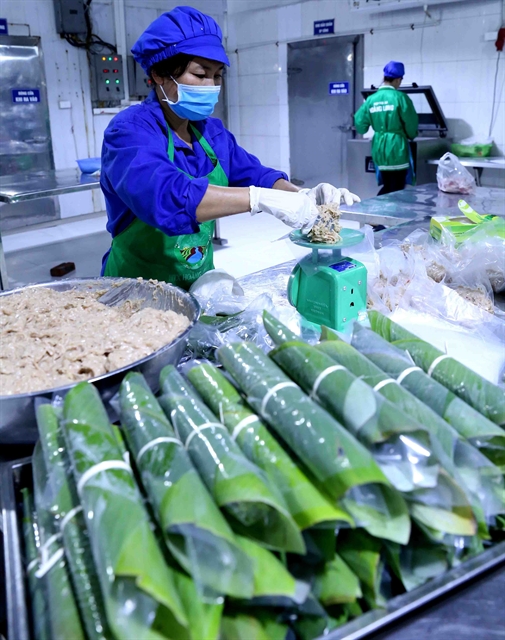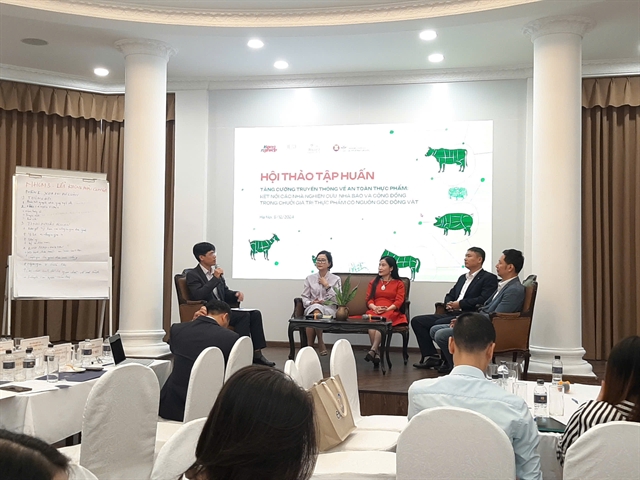 Economy
Economy

 |
| Experts discuss measures to enhance food safety in training workshop on Enhancing Communication on Food Safety: Connecting Researchers, Journalists, and Communities in the Animal-Based Food Value Chain on Thursday in Hà Nội. VNS Photo Tố Như |
HÀ NỘI – Việt Nam has faced many food safety issues, such as food containing toxic chemicals, microbial contamination and misinformation about food origins, said Dr Phạm Đức Phúc, director of the Institute for Environmental Health and Sustainable Development.
“To effectively communicate risks, transparency must be ensured. Messages should resonate with and show empathy towards the target audience, information should be delivered promptly and scientific evidence should support the messages,” Phúc told a training workshop on 'Enhancing Communication on Food Safety: Connecting Researchers, Journalists, and Communities in the Animal-Based Food Value Chain' on Thursday in Hà Nội.
It is also essential to recognise the role of traditional production chains for animal-based food products, especially pork, and to develop appropriate interventions and communication strategies to ensure food safety in these chains, he said.
Encouraging community participation is also crucial in building social trust. It is also important to address uncertain or controversial issues and handle negative information tactfully, he added.
The workshop also included a panel discussion on 'Innovative Approaches in Food Safety Communication', which clarified the connections between risks, scientific information and communication while proposing more specific and effective solutions for communicating risks regarding food safety.
Currently, consumers’ awareness of food safety has significantly improved, which has driven Việt Nam’s policymaking mechanisms to become more robust, in turn forcing businesses to meet higher food safety standards.
From a management perspective, Nguyễn Bá Trình, deputy head of Hà Nội’s Đông Anh Market Management Board, said that, aside from disseminating food safety policies and regulations to vendors, the management board collaborates with relevant authorities to collect and analyse product samples.
The results are shared through market activity bulletins and with vendors to enhance awareness and improve food safety standards at traditional markets, he said.
Hà Thúy Hạnh, deputy director of the Association of Farms and Agricultural Enterprises, said that food safety is now a top priority for businesses as it directly affects their profits and sales.
In addition to ensuring input quality, businesses demonstrate their compliance through certifications such as ISO 22000:2018, Hạnh said.
Export companies must also meet the specific standards of importing countries, such as Halal certification and animal welfare requirements. Companies are adopting tools like blockchain and QR codes for product traceability to manage their supply chains effectively, she said.
However, certifications are valid for a limited period, and obtaining them involves costs. Some businesses, lacking sustainable markets, secure certifications initially but fail to renew them later.
"Food safety is a fundamental societal need. When consumers change their perceptions, producers and businesses must adapt," Hạnh said.
She stressed the importance of creating effective communication strategies with key highlights to attract readers' attention.
Regarding the criteria for effective, transparent and beneficial communication on food safety, Dr Lưu Quỳnh Hương from the Laboratory for Genetic Resource Conservation (Veterinary Institute) pointed out that information agencies play a key role in conveying scientific research findings to the public.
However, scientific research must be communicated accurately, selectively and in simple, understandable terms.
“For example, regarding food poisoning caused by Salmonella bacteria, studies over many years have shown that contamination rates remain consistently high, ranging from 30 to 80 per cent in meat samples collected from markets,” Hương said.
“Nevertheless, Salmonella includes over 2,600 different strains, not all of which cause food poisoning,” she said.
Therefore, not all foods testing positive for Salmonella are hazardous. Communication agencies must ensure their reports avoid causing unnecessary public concern, she said.
Journalist Dương Đình Tường from Nông nghiệp Việt Nam Newspaper, said: "Changing consumer attitudes will lead to changes in producer behaviour. Consumers' leniency leads to producers' leniency. If we continue to buy cheap and attractive products without concern for their origin, we are supporting unsafe food production."
According to the journalist, in communicating about food safety, it is important to make complex issues simple, use relatable examples for consumers and leverage diverse media platforms to deliver messages effectively.
In the food value chain, food safety has emerged as a pressing issue that requires cross-sectoral collaboration and decisive efforts from researchers, regulatory agencies and especially the media, he said.
Through this workshop, a core network of journalists will be established to raise public awareness about food safety. VNS